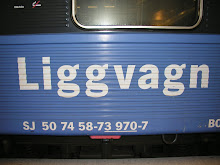Moments in time captured with various odd symbols referred to in the lingua franca as letters.
About Me
Tuesday, March 24, 2009
Thinking high density vs. urban sprawl
You are silent oh readers of these words, it would be nice to hear you speak your minds every now and again. Today I was sitting reading from Richard Florida´s book "Cities and the Creative Class" and while I can´t find myself agreeing with everything he says, I do find it interesting in many ways. He talks about how to create cities that are attractive to creative individuals and how this approach will lead to better local development (mostly in an economic perspective) but of course any type of development has externalities (which is where I am concerned). I keep thinking back to the US and its development patterns: how the ususal thing to do is to build office parks, residential areas, and shopping centers and all of these separated by wide roads and zoning differences. What do we lose in this system? First I would argue we lose exercise; every one has to drive to work. Because we all have to drive to work we lose time in traffic (the US government has figures on how much money is lost in traffic jams every year and its not pennies we are talking about here). By living in Suburban growth patterns i.e. the cul-de-sac lifestyle, we isolate ourselves from others (this is even more true in the case of gated communities which are honestly class segregation). Why do we live like this? The standard laissez fair argument would be that this is what the market desires. My counter to that is that there are other growth patterns that could be tried in cities, but no one is willing to innovate or be creative (note here the influence of Florida). My background studies at the moment have a lot to do with sustainable development and so I take that type of approach to building and development as a whole: our housing situation in the US is not a long term approach, nor is the shopping center development. These areas are built for twenty year boom periods and not for long term stability. That is why suburbs all look the same. What would happen if some developer in coordination stepped outside the box and created more interesting places to live that didn´t just rely on spectacle (getting a famous architect)? Would it work? Could we produce more interesting neighborhoods with more stable living and work patterns? Or is the suburb really as good as they said it would be in the fifties?
Subscribe to:
Post Comments (Atom)
Followers
Blog Archive
-
▼
2009
(109)
-
▼
March
(24)
- Today is Spring
- Monday Monday
- Portugal-Sweden match report
- I want to know
- The little PM that could
- Thinking high density vs. urban sprawl
- Its a good feeling when
- Which is more absurd?
- Thoughts on Watchmen
- Some more thinking...
- Bored and Amused
- Looking for inspiration
- Building tanks
- Spring are you upon us?
- The Yellow Journalism trail...
- In defense of RL
- BBC
- Its a...
- I have this little feeling...
- Socialism: the joke is on you!
- Nationalist moment of the day...
- Republican Prancing
- Thomas Mann
- Case of the Mondays
-
▼
March
(24)

No comments:
Post a Comment